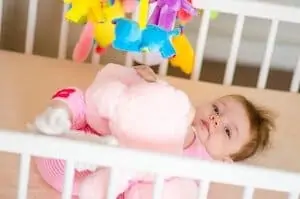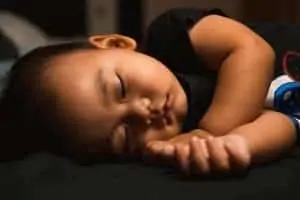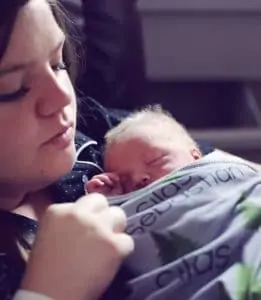Babies don’t sleep well when they’re cold, but who can blame them? That’s why parents need to figure out how to keep their baby warm in the crib.
Blankets are a huge no-no in the crib because they pose a suffocation and SIDS risk for infants. Experts recommend that parents never use blankets in cribs because their baby might flip them on top of their face. That dramatically increases the risk of suffocating or overheating.
So, how are you supposed to keep your baby warm in the crib?
This is a real question that parents have. Babies cannot regulate their body temperature, so it’s up to their parents to make sure that they have everything they need to stay warm in their cribs, even in the winter.
Here are some suggestions to help keep your baby warm in the crib.
How to Keep Baby Warm in the Crib Without Blankets?
Experts recommend that parents remove all blankets, crib bumpers, pillows, and anything else from their baby’s crib. They pose serious suffocation risks, dramatically increasing the rate of SIDS. Since blankets aren’t considered a safe choice for babies, parents need to know how to keep their baby warm in the crib without blankets.
Here are some options.
Maintain a Safe Nursery Temperature
The best way to keep your baby warm in the crib is to make sure their nursery is at the right temperature. Spend time in your baby’s room to determine if it’s comfortable for you. If it’s too cold or too hot, you’ll know and be able to adjust the temperature as needed.
Doctors recommend keeping your baby’s room between 68-72℉. Keeping the room hotter than 72℉ increases the risk of SIDS. Any colder than 68℉ means your baby might be too cold; remember, babies cannot regulate their temperature.
Use Sleep Sacks and Wearable Blankets

Since you can’t use blankets in cribs, sleep sacks and wearable blankets are the next best choice. While you can’t put a blanket over the top of your baby, a wearable blanket, or sleep sack, is a safe choice. They’re like a cozy nightgown with a bottom zippered closed.
Babies cannot remove their sleep sacks, so they don’t pose the same worries as a blanket. Sleep sacks are one layer; look at the TOG rating to determine how warm the fabric is and when you should use it.
Sleep sacks are the safest alternative to blankets; make sure you have them for your baby.
Relative: Learn the differences between a sleep sack and swaddle blanket.
Wear Appropriate Layers
When it comes to how many layers to put under a sleep sack, the typical recommendation is one more layer than you would wear.
If you notice that your baby is still cold with a sleep sack, change the layers underneath. Consider using a sleeper rather than an onesie, or make sure you have pants on your baby.
Try a Nursery Heater
Use spacing heaters is a controversial topic; some refuse to use them because they increase the risk of house fires. The idea of using a space heater in a baby nursery is scary.
However, some people live in older homes that are drafty and have less insulation than newer homes. That makes it harder to maintain proper temperatures that are comfortable for babies.
If you use a space heater, make sure it’s not placed close to the crib. The farther away, the better and safer it is for your baby. When you pick a space heater for a nursery, choose one with safety features, such as overheating protection and a tip-over shutoff.
Always make sure you plug a space heater into the wall. Using a power strip is a big fire hazard. I suggest that you look for space heaters designed for a nursery. Some even have childproof lock switches so that your baby can’t accidentally press buttons when they play in their bedroom.
How to Keep Baby Warm in the Crib During the Winter?
One of the most challenging times to keep your baby warm in the crib is in the winter. When the temperatures dip outside, you might notice that your house gets colder as well. You have to change your tactics to keep your baby warm during the winter.
Here are some suggestions.
Use a Thicker Sleep Sack
In the summer, parents should use a breathable cotton sleep sack and prevent their baby from overheating. In the winter, switch to using a microfleece sleep sack that provides more warmth for your baby.
Know the numbers:
All sleep sacks have a TOG rating from 0.5 to 3. A rating of 0.5 is for 100% cotton fabrics, ideal for warm weather. A rating of 3 is the highest possible, and it’s best for cold temperatures. Depending on the temperature of your house, a winter sleep sack might be between 2-3.
Add Extra Layers
If you don’t want to wear a thicker sleep sack or find that it still doesn’t keep your baby warm, add an extra layer underneath. When you start adding layers, make sure you regularly check your baby to ensure that your baby isn’t too hot. Overheating is a serious risk when you start adding extra layers.
Set The Room Temperature Higher
If you have the room temperature set around 68-70℉, try increasing it by one or two degrees. Don’t go higher than 72℉ because it increases the risk of SIDS.
Move The Crib Away from Drafts
Make sure you keep your baby’s crib away from windows that might cause a draft. You should keep the crib on an inside wall rather than an outside wall; those are colder and make it harder for your baby to feel comfortable while sleeping.
How Can I Make My Baby’s Crib Warmer?
Aside from keeping your baby warm without blankets, you also can make your baby’s crib warmer. Here are two tips that you should try.
1. Cozy Sheets
Do you love getting into bed with cozy, warm sheets? Some fabrics, like flannel, are warmer and will help your baby feel cozier while sleeping.
2. Preheat with a Hot Water Bottle
Another trick to warming up your baby’s crib is to preheat where your baby will lay with a hot water bottle or heating pad. You don’t want it to be scorching hot; warm is perfect. This helps your baby fall asleep faster as well.
Signs That Your Baby is Cold in the Crib

Unlike having a too hot baby, being too cold doesn’t increase the risk of SIDS. It does make your baby more likely to wake up throughout the night and fuss. If you were cold in the middle of the night, you’d do the same thing.
Here are some signs that your baby is too cold in the crib.
- Cold chest and neck
- Pale skin
- Fussiness
- Trouble sleeping
- Sudden sneezing
Final Thoughts
Keeping your baby warm in the crib is important; you want your baby to sleep well at night. Ditch the blankets, which are unsafe for babies. Instead, keep your baby’s nursery at a safe, warm temperature and use sleep sacks for your baby.
Hey, this is Linda. My biggest accomplishment in life is being a mother of four children. Their current ages range from almost ten years old down to 20 months old.
I’m passionate about writing parenting articles because I understand so well all of the problems and trials you face as a parent. From breastfeeding woes to budgeting problems and behavior problems, along with everything in between, chances are I’ve faced it over the last ten years. Read more about Linda here.






